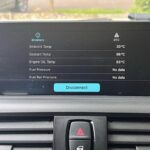The ELM327 Bluetooth OBD-II dongle is a popular tool for car enthusiasts and mechanics alike, allowing wireless connection to a vehicle’s On-Board Diagnostics system. This handy device plugs into your car’s OBD2 port and, in theory, should communicate seamlessly with your smartphone or computer via Bluetooth, providing access to a wealth of data about your car’s engine and performance. Many users, however, particularly those within the Apple ecosystem, run into a frustrating roadblock: iOS devices like iPhones and iPads often struggle to pair with these Bluetooth OBD2 adapters. This raises a critical question for those seeking to use OBD2 tools with their iPhones: what is a Bluetooth workaround for OBD2 when using iOS devices?
The core issue lies in the Bluetooth compatibility between ELM327 devices and iOS. While Android devices generally recognize and pair with ELM327 Bluetooth dongles without issue, iPhones and iPads often fail to even detect these devices in their Bluetooth settings. This isn’t a problem with the OBD2 protocol itself, which is a standardized system used across most car brands since the 1980s for accessing diagnostic information. The ELM327 chip, widely used in these dongles, is designed to communicate using Bluetooth, but the specific Bluetooth profiles and protocols it employs can sometimes clash with Apple’s iOS operating system.
One primary reason for this incompatibility is often attributed to Apple’s stricter Bluetooth protocol requirements compared to Android. ELM327 Bluetooth dongles frequently utilize Bluetooth Classic, which, while functional, may not always align with the way iOS devices are optimized to handle Bluetooth connections, particularly for data transfer in this manner. Apple devices are often geared towards Bluetooth Low Energy (BLE) for many types of connections, although Bluetooth Classic should still be supported for generic devices. However, the implementation and specific profiles used by some ELM327 devices might not be fully compatible with iOS’s interpretation.
So, what are the Bluetooth workarounds for OBD2 when using iOS? Since direct Bluetooth pairing of many ELM327 devices with iOS is problematic, the most common and effective workaround is to sidestep Bluetooth altogether. This is achieved by using OBD2 adapters that connect via Wi-Fi instead of Bluetooth. Wi-Fi OBD2 adapters essentially create their own wireless network, which your iPhone or iPad can connect to directly. This method bypasses the Bluetooth pairing issues and allows iOS apps designed for OBD2 diagnostics to communicate with the adapter and, consequently, your car’s computer.
Another potential, though less universally applicable, workaround involves checking for specific Bluetooth OBD2 apps that are designed to work with iOS. Some app developers may have found ways to optimize communication or utilize specific Bluetooth profiles that improve compatibility with certain ELM327 adapters. However, compatibility can vary greatly, and it’s crucial to research app and adapter combinations thoroughly before purchasing. User reviews and compatibility lists can be valuable resources in this regard.
In conclusion, while directly pairing a standard ELM327 Bluetooth OBD2 dongle with an iOS device often presents challenges, the primary workaround is to utilize Wi-Fi OBD2 adapters. These adapters circumvent the Bluetooth incompatibility issues by creating a direct Wi-Fi connection with your iPhone or iPad. While exploring specific iOS-compatible Bluetooth OBD2 apps might offer solutions in some cases, Wi-Fi adapters provide a more reliable and broadly applicable “Bluetooth workaround” for accessing your car’s OBD2 system with Apple devices. For users deeply invested in the Apple ecosystem, opting for a Wi-Fi based OBD2 adapter is generally the most straightforward path to successful vehicle diagnostics.
